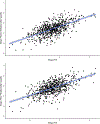Longitudinal associations between positive affect and relationship quality among children and adolescents: Examining patterns of co-occurring change
- PMID: 31524419
- PMCID: PMC7073307
- DOI: 10.1037/emo0000682
Longitudinal associations between positive affect and relationship quality among children and adolescents: Examining patterns of co-occurring change
Abstract
The broaden-and-build theory of positive emotions suggests that the experience of positive affect (PA) and positive interpersonal experiences should mutually reinforce each other over time, potentiating upward spirals of PA and social well-being. Informed by this upward spirals hypothesis, the present study used parallel process latent growth curve modeling to evaluate co-occurring trajectories of PA and parent- and peer-relationship quality in a sample of 680 youth aged 8 to 16 years (M = 11.87, SD = 2.41, 56.7% female). Youth PA and relationship quality were assessed every 18 months for 3 years (3 total assessments). Results of parallel process latent growth curve modeling analyses indicated positive correlations between trajectories of PA and trajectories of both parent- and peer-relationship quality. Consistent with tenets of the broaden-and-build theory of positive emotions, the findings suggest that youth PA and experiences of high-quality relationships demonstrate reciprocal patterns of growth, with implications for youth health and well-being. (PsycInfo Database Record (c) 2021 APA, all rights reserved).
Conflict of interest statement
Figures


References
-
- Abraham MM, & Kerns KA (2013). Positive and negative emotions and coping as mediators of mother-child attachment and peer relationships. Merrill-Palmer Quarterly, 59, 399–425. doi:10.1353/mpq.2013.0023 - DOI
-
- Barrett P (2007). Structural equation modelling: Adjudging model fit. Personality and Individual Differences, 42, 815–824. doi:10.1016/j.paid.2006.09.018 - DOI
-
- Burns AB, Brown JS, Sachs-Ericsson N, Plant EA, Curtis JT, Fredrickson BL, & Joiner TE (2008). Upward spirals of positive emotion and coping: Replication, extension, and initial exploration of neurochemical substrates. Personality and Individual Differences, 44, 360–370. doi:10.1016/j.paid.2007.08.015 - DOI - PMC - PubMed
MeSH terms
Grants and funding
LinkOut - more resources
Full Text Sources
Other Literature Sources

